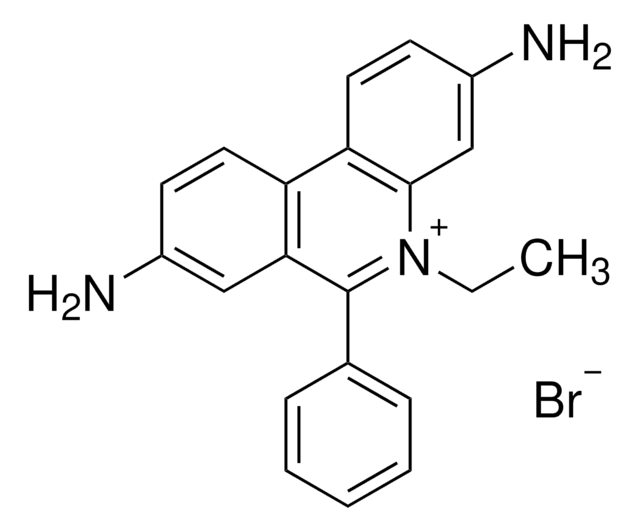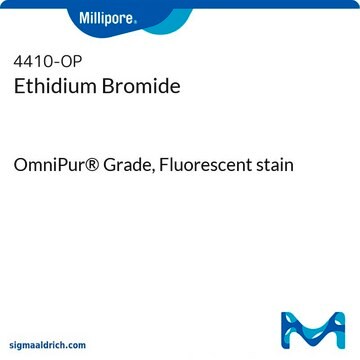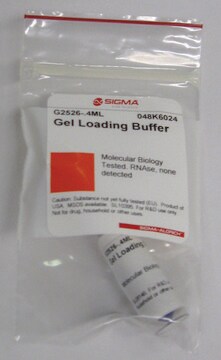E7637
Ethidium bromide
BioReagent, for molecular biology, powder
Sinônimo(s):
3,8-Diamino-5-ethyl-6-phenylphenanthridinium bromide, EtBr, Homidium bromide
About This Item
Produtos recomendados
grau
for molecular biology
Nível de qualidade
linha de produto
BioReagent
forma
powder
técnica(s)
electrophoresis: suitable
pf
260-262 °C (dec.) (lit.)
fluorescência
λex 360 nm; λem 590 nm in PBS
λex 526 nm; λem 605 nm (10 mM TBE; pH 8.0;)
λex 526 nm; λem 605 nm in aqueous buffer
adequação
suitable for gel electrophoresis
cadeia de caracteres SMILES
[Br-].CC[n+]1c(-c2ccccc2)c3cc(N)ccc3c4ccc(N)cc14
InChI
1S/C21H19N3.BrH/c1-2-24-20-13-16(23)9-11-18(20)17-10-8-15(22)12-19(17)21(24)14-6-4-3-5-7-14;/h3-13,23H,2,22H2,1H3;1H
chave InChI
ZMMJGEGLRURXTF-UHFFFAOYSA-N
Procurando produtos similares? Visita Guia de comparação de produtos
Aplicação
Frameshift mutagen which intercalates double-stranded DNA and RNA.
Ações bioquímicas/fisiológicas
Reconstituição
produto relacionado
Palavra indicadora
Danger
Frases de perigo
Declarações de precaução
Classificações de perigo
Acute Tox. 1 Inhalation - Acute Tox. 4 Oral - Muta. 2
Código de classe de armazenamento
6.1A - Combustible acute toxic Cat. 1 and 2 / very toxic hazardous materials
Classe de risco de água (WGK)
WGK 1
Ponto de fulgor (°F)
Not applicable
Ponto de fulgor (°C)
Not applicable
Equipamento de proteção individual
Eyeshields, Faceshields, Gloves, type P3 (EN 143) respirator cartridges
Certificados de análise (COA)
Busque Certificados de análise (COA) digitando o Número do Lote do produto. Os números de lote e remessa podem ser encontrados no rótulo de um produto após a palavra “Lot” ou “Batch”.
Já possui este produto?
Encontre a documentação dos produtos que você adquiriu recentemente na biblioteca de documentos.
Conteúdo relacionado
Ethidium bromide is a well-known and widely used fluorescent dye in biotechnology research.
Nossa equipe de cientistas tem experiência em todas as áreas de pesquisa, incluindo Life Sciences, ciência de materiais, síntese química, cromatografia, química analítica e muitas outras.
Entre em contato com a assistência técnica






